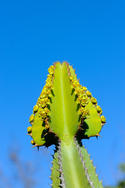
The branches of this tree are modified into cylindrical photosynthetic organs.
The process of synthesizing glucose food from carbon dioxide and water is usually the role of the leaves, the part of the tree usually endowed with green chlorophyll (which traps the sun’s energy and powers the food making process).
The leaves of the rubber euphorbia are however scale-like in appearance and virtually non-existent.
Rubber Euphorbia Uses
All parts of the rubber euphorbia are well supplied with an extremely toxic milky latex which bleeds profusely from the tree should it be damaged in any way. This latex has been used traditionally as a fish poison and in native cures for sexual impotence. For use as a medicinal treatment, it has to be administered with extreme care as even a small excess of ingested latex can result in death by internal bleeding in the gut. Animals such as black rhino and even nyala eat the stems of the tree without ill effect.
The poisonous nature of the rubber euphorbia has led to its cultivation as a hedge to enclose homesteads and protect them from unwanted intruders. Sometimes the rubber euphorbia is also known as the rubber-hedge euphorbia for this reason. Rubber euphorbias are believed to repel moles and insects and are useful around homesteads to keep these kinds of pests at bay too.
Rubber Euphorbia Appearance
The rubber euphorbia is unmistakable for its bizarre growth form which resembles a tangle of green spaghetti albeit this emanates from a solid main trunk.
The rubber euphorbia generally grows in rocky areas but shows a great deal of resilience in its habitat requirements. Early traders took specimens home with them to India and the Far East where the plants have flourished.
The flowers are borne on the ends of the spaghetti-like branches and thereafter develop into three-lobed capsule fruits which ripen to an attractive pink colour.
Euphorbia Family
Another euphorbia occurs fairly commonly in the Lowveld and is called the Lowveld or Lesser Candelabra Euphorbia (Euphorbia cooperi). This tree is said to have the deadliest latex of all the euphorbias and will irritate the skin and throat of a person simply standing in the proximity of a plant that is seeping latex.
This euphorbia is shaped like a candelabrum, each ‘candle-stick’ comprising separate heart-shaped constrictions and the main stem decoratively dimpled by old branches that have died and fallen off. The flowers and fruit are borne of the tips of each branch and are yellow and red respectively giving the tree the impression that the candles have been lit. Despite the poisonous properties of the plant, baboons and doves eat the flowers and fruit.
Rubber Euphorbia Fast Facts
Height - Up to 10 m
Growth form - Unique with a single stem and tangled green cylindrical branches without leaves
Leaf type - Simple, scale-like
Leaf arrangement - NA
Leaf margin - NA
Habitat - Varied habitats including rocky outcrops
Deciduous or not - Evergreen
Most notable fruit/flowering season - Fruit: Nov to Jan, Flowers: Oct to Dec
By Megan Emmet